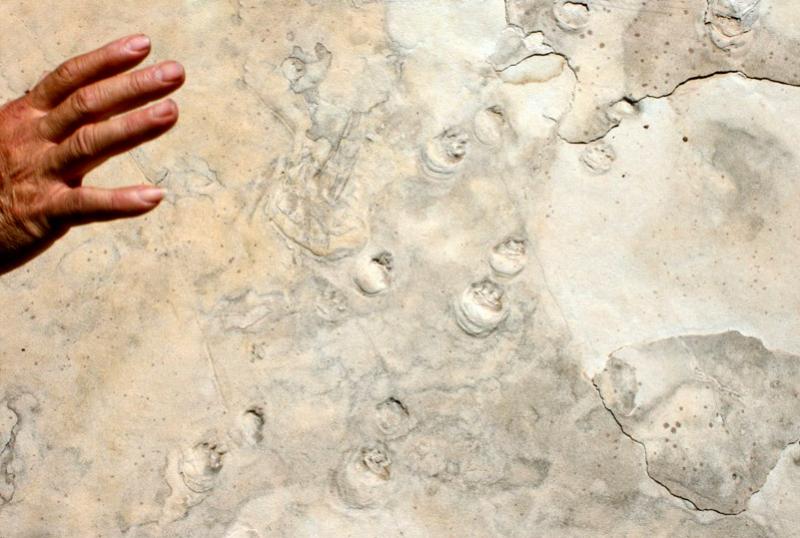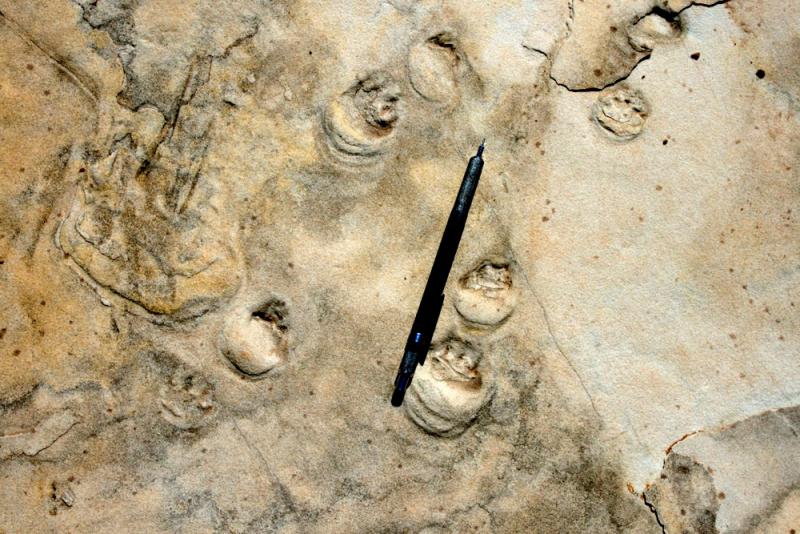About eleven miles past the launch point to the Colorado River in the Grand Canyon, boats just beginning their voyage down the turbulent, vermillion river often pull over to the left bank to examine a bedroom-sized slab of pale sandstone. This block of the Coconino Sandstone long ago detached from vertiginous cliffs high above, skidding to an off-kilter stop on layers of maroon shale. Rafters unaccustomed to walking on a swaying boat gingerly find their sea legs as they wend their way around bulky, unfamiliar gear. Once rafters stand on the banks of the Colorado, the coolness of the river air is swept away by with blast furnace heat emanating from dark, sun-soaked rocks. And there, amidst these rocks, lies a remarkable thing.

About two hundred and seventy-five million years ago, a small lizard ascended a hill of dune sand. Perhaps it paused for moment, tasting the cool morning air with its forked tongue, before scampering up the sandy slope glistening with morning dew. The dew created a potato chip-thin crust on the dune, through which the lizard’s feet broke, splaying sand behind. The lizard scampered over the crest and vanished from history. But circumstances would conspire to preserve its delicate, fleeting footsteps, recording just a few moments in the lifetime of an animal who perished incomprehensibly long ago. Imagine if the only record of your existence on earth came from what you did during five seconds randomly selected out of all the moments of your life. At least it would be a touchstone of your existence. When we put our hands to the tiny footprints left behind on this remote slab of rock, we fist-bump our ancient cousins across deep time.

The Coconino Sandstone is famous for preserving the footprint trackways of vertebrates. Because the Coconino records textbook wind-blown features—large dunes preserved as cross-beds, individual sand grains that look under a scanning electron microscope like frosted glass—we infer that the animals who made these tracks lived in a vast desert that covered what would become North America. Today’s deserts are smaller, but when you visit modern dunes, you can still see many kinds of analogous trackways; arthropod and vertebrate footprints are ubiquitous yet ephemeral, disintegrating with the first gust of wind. Footprints of the kind recorded in the Coconino Sandstone are very rarely fossilized, but they record normal, everyday processes.
Creationists have a very different interpretation. For them, these footprints record the most unusual event of all: Noah’s Flood.
One of the young earth creationists making this argument is Leonard Brand, a professor of biology and paleontology at Loma Linda University, a private Seventh-day Adventist college. Brand has published a series of papers on Grand Canyon trackways in peer-reviewed geology journals such as Geology, Ichnos, Journal of Paleontology, and Palaeogeography, Palaeoclimatology, Palaeoecology. In these papers Brand describes experiments he conducted by compelling (presumably indignant) amphibians and lizards to move up artificial sand hills covered by water. Brand then examined the prints and compared them to fossil trackways such as those found in the Grand Canyon. The creationist book Grand Canyon: Monument to Catastrophe summarized Brand’s conclusions this way:
...when the locomotion behavior of the living amphibians is taken into account, the fossilized trackways are best understood as suggesting that the animals were entirely under water (not swimming at the surface) and moving upslope (against the current), in an attempt to get out of the water. This interpretation fits with the concept of a global Flood.
To young earth creationists, such trackways represent the physical record of hapless animals vainly trying to escape the rising Flood waters.
The creationist model of the Flood has a serious problem if the footprints in the Coconino were made on land rather than in water; the Coconino is sandwiched right in the middle of rock layers that according to the Flood model were laid down rapidly during the Flood year. You can’t easily explain a land-deposited layer of rock during worldwide aqueous conditions. This is the broader subtext of why creationists are so determined to show that the Coconino footprints could have formed by drowning animals scurrying to higher ground, and we’ll address the Coconino specifically in a future post, but for now let’s examine a few contradictions in the curious logic they employ in this argument:
Contradiction 1: Creationists claim these footprints were made as Flood waters rose and animals madly tried to get to higher ground. Presumably the opening of the “fountains of the deep” would have caused violent, tsunami-like flows. Imagine a roiling deluge, brown with disturbed sediment, choked with vegetation and countless drowned bodies, sweeping across entire continents. If these footprints were made in conditions such as the Brand experiments, it is hard to understand how delicate tracks in sand could have remained when the violent, turbulent waters of the Flood smashed into them.
Creationists have acknowledged this problem. In Whitcomb and Morris’ 1961 young-earth creationist book The Genesis Flood, they addressed the delicacy of such fossils and noted:
It seems clear that the only way in which such prints could be preserved as fossils is by means of some chemical action permitting rapid lithification and some aqueous action permitting rapid burial. Some sudden and catastrophic action is again necessary for any reasonable explanation of the phenomena.
This is special pleading, a unsatisfying deus ex machina concocted to hide the fatal flaws in an unsupportable argument. A far more parsimonious explanation is that the footprints were simply made on land through normal processes.

Contradiction 2: Creationists say the Coconino footprints were made as the Flood water rose, but the Coconino is well above the rocks they indicate as the beginning of the Flood. In fact, the Coconino sits right in the middle of the rock layers creationists say were laid down as “broad sedimentary deposits in northern Arizona from the early part of Noah’s Flood” (as Grand Canyon: Monument to Catastrophe puts it).
The base of these rocks is the Great Unconformity, which creationists interpret as the “early erosion and the onset of Noah’s Flood.” Yet the Coconino layers are thousands of vertical feet above the Great Unconformity. How was it that animals were still alive and scampering out of the way of Flood waters when all these lower units—the Tapeats Sandstone, the Tonto Group, the Redwall Limestone, and many more—were not yet deposited during the Flood year?
It simply does not make sense. We can walk up and put our hands on clear evidence that scuttles the idea of a literal Noah’s Ark and a historic worldwide Flood. Yet like rafters just starting down the Colorado River, we’ve only begun our journey into the strange world of creationist geology.
Next up: Creationist Grand Canyon Claim #4: How the Rocks of the Grand Canyon Were Made By Noah’s Flood
